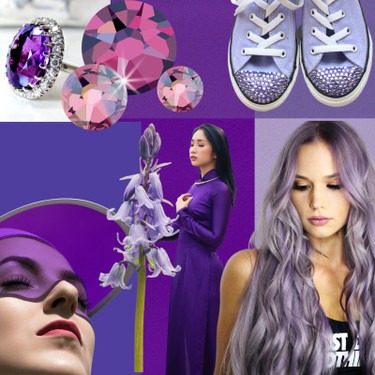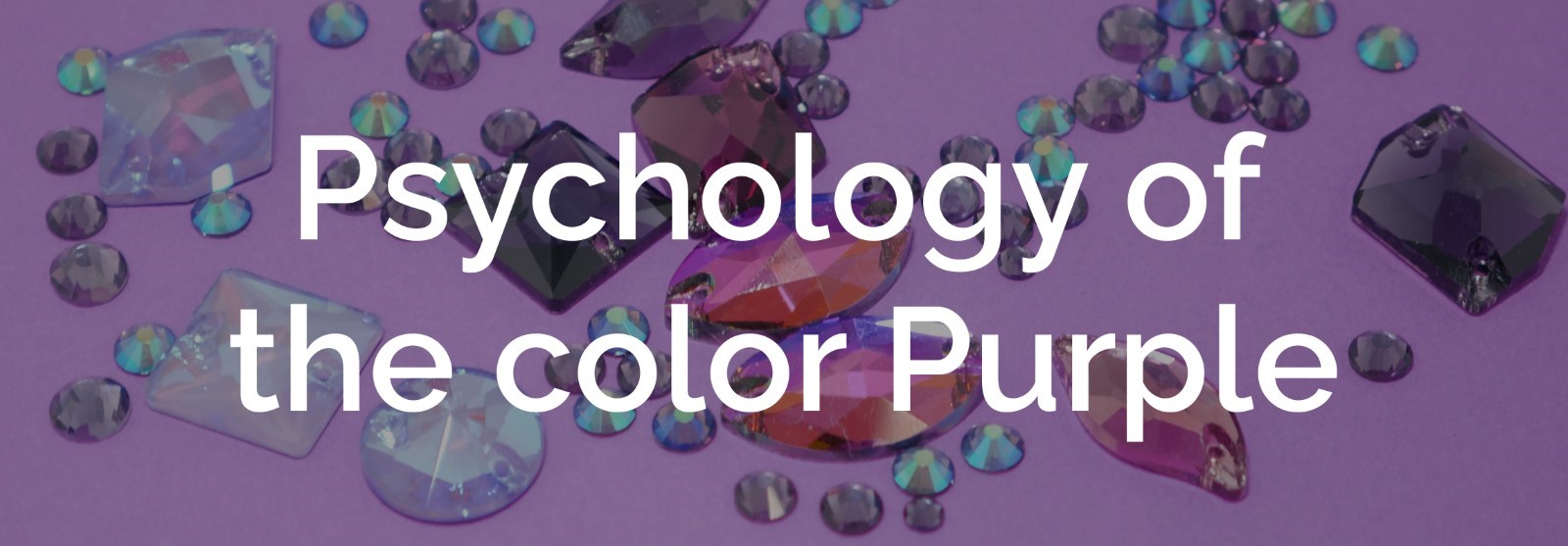Purple Color Psychology: What Does the Color Purple Signify?
Posted by Rhinestones Unlimited on Jun 26th 2023
What Does the Color Purple Signify?
Have you ever wondered why the color purple makes us feel so mesmerized and charmed? You can find shades of purple just about everywhere: in clothing, décor, art—even food, whether it’s a dusky mauve or eye-catching peacock! While many of us love the mysterious hue for its beauty alone, did you know that purple also has a fascinating psychological value attached to it? Let’s take a closer look at purple color psychology to learn what this enigmatic tone signifies.
What Does Purple Signify?
Most people associate the color purple with royalty, nobility, and luxury. It is a color of sophistication and elegance that conveys power and wealth. As such, it symbolizes ambition, creative expression, independence, and imagination—for many in the modern world, these are all elements we desire to possess or cultivate within ourselves.
However, purple has varying connotations depending on the context and culture, making it crucial to understand how to interpret the shade in different environments.
What’s in a Shade? The Meaning of Different Shades of Purple
Not all purples are created equal! The shade of purple can change its meaning and energy. Let’s explore some of the most common shades of purple and their interpretations.
Lavender
Soft and light, lavender represents femininity, romance, and calmness. It is also known to signify refinement and grace. Shown above is MAXIMA Crystals by Preciosa in the color Tanzanite.
Violet
This vibrant hue resembles an even mix between blue and red. With its vibrance and intensity, it evokes the feeling of passion, creativity, and ambition. Featured above, is the Light Violet color rhinestone by Priceless.
Royal Purple
Rich and regal, this shade of purple reflects power, wealth, royalty, and luxury. Since the color is associated with royalty, it also implies a sense of authority and respect. A great example of royal purple is Deep Tanzanite by Priceless, shown above.
Mauve
This unique hue of purple is gentle and soft, often associated with nostalgia and sentimentality. It can also represent grace and gentility. Exemplifying the grace of mauve above is Preciosa’s Amethyst Opal.
Amethyst
A darker hue of purple, amethyst epitomizes mystery and exploration. It’s also been known to symbolize insight and transformation. Shown above is a rhinestone in the color Amethyst by Lux.
Cultural Meanings: Purple All Over the World
Purple has a diverse range of symbolism and interpretations across different cultures. Let’s explore some fascinating meanings of purple around the globe.
Ancient Rome & Greece
Both civilizations held the color in high regard, associating it with nobility, luxury, and power. The production of purple dyes was an expensive and complex process, so purple clothing was largely reserved for the elite.
Eastern Cultures
In Buddhism, purple represents wisdom and spirituality. Japanese culture associates purple with wealth and prosperity, while in China, the color symbolizes spiritual awareness and mental growth. Meanwhile, in Hinduism, people correlate purple with the divine. They frequently use the color in religious ceremonies and rituals. Purple also has connotations of royalty, nobility, sophistication, and mystery.
Africa
Purple is a vibrant and important color in African cultures. The Massai people of Kenya associate the color with healing, while the Yoruba people of Nigeria use purple to mark special occasions and celebrate life’s milestones.
Western Cultures
In Western cultures, people view purple as a symbol of creativity, mysticism, and pride. In the United States and Europe, it is also closely linked to the LGBTQ+ community and the fight for equality.
The Royal History of Purple: A Color Made for Kings and Queens
The rich history of purple is as fascinating as the color itself. Let’s delve into some fascinating historical moments involving our favorite hue.
The Ancient Phoenicians
The Phoenicians were the first to produce a purple dye called Tyrian purple. They would extract this rare and costly dye in minuscule amounts from the shells of certain sea snails, which made it highly valuable and sought-after.
Roman Emperors
Julius Caesar reserved the wearing of purple togas for the emperor and the highest-ranking members of society. This decree led to purple becoming known as the “color of power.”
The Byzantine Empire
The Byzantine Empire became known as the “Empire of Purple” due to its use of Tyrian purple in garments and decorations. The imperial color was said to be a symbol of divine power and eternal majesty.
British Aristocracy
Queen Elizabeth I declared that only members of the royal family could wear purple robes. As such, she adopted the nickname “The Purple Queen” and ensured purple remained a status symbol of wealth and nobility.
The Benefits of Purple in Our Lives
Purple is more than just a pretty hue. It can have a profound impact on our emotions, thoughts, and overall well-being. Let’s uncover the benefits of surrounding ourselves with this captivating color!
Serenity and Calmness
Purple’s soothing shades, such as lilac and lavender, promote relaxation and calmness. Surrounding ourselves with these hues can provide a tranquil environment, making it easier to unwind after a long day or meditate in peace.
Creativity and Imagination
Richer shades of purple, such as plum or eggplant, can fuel creativity and ignite our imaginations. Their vibrancy stirs the senses and encourages us to think outside the box. Incorporating these shades in our workspace or artistic endeavors can foster self-expression and innovation.
Sensitivity and Intuition
Purple exudes sensitivity and intuitive understanding, allowing us to see beneath the surface and perceive hidden truths. Its nurturing and empathetic qualities foster emotional connections and help create safe spaces for communication.
Power and Luxury
The regal shades of purple, such as royal purple or violet, bring a sense of power and luxury. Wearing these colors can boost our confidence and create an aura of authority. It also symbolizes ambition, making it the perfect hue for setting goals and achieving success!
The power of purple is undeniable! People have been captivated by this enchanting color throughout history, whether it’s a light, flirty shade or a deep, luxurious hue.
Now that you understand more about purple color psychology and what the color purple signifies, you can successfully incorporate it into your designs or manicures. Check out our full catalog of purple rhinestones here!
Our selection of rhinestones is sure to make any look shine! Our website, RhinestoneU.com, has the perfect product for you, whether you’re going for a bold, vibrant statement or something more subtle and romantic. With our wide range of shapes, colors, sizes, and finishes available, you can create a purple masterpiece in no time.

 Bulk
Bulk Crystal
Crystal Crystals
Crystals  Sales &
Sales &


